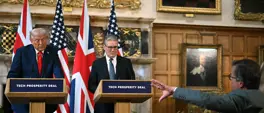Supreme Court ruling to reshape SA's approach to intellectual property and consumer protection?
Tasleem Gierdien
26 June 2025 | 8:39Looking at the challenges faced when different entities hold rights to the same trademark in different jurisdictions.
- Lester Kiewit
- Good Morning Cape Town with Lester Kiewit
- John Maytham
- CapeTalk
- Counterfeit goods
- Consumer issues
- Supreme Court of Appeal (SCA)
- Supreme Court of Appeal
- Trademark
- Consumer protection
- Intellectual property

Picture: © sebra/123rf.com
John Maytham (standing in for CapeTalk's Lester Kiewit) speaks to Dale Healy, a partner at Adams & Adams - a law firm specialising in intellectual property law.
Listen below:
In a precedent-setting decision, the Supreme Court of Appeal has delivered a ruling that is set to reshape the country’s approach to intellectual property enforcement and consumer protection.
The court ruled that authentic designer goods cannot be classified as counterfeit, even when imported without the consent of local trademark holders.
The ruling came after Yossi Barel, who holds the South African trademark rights to the ENRICO COVERI brand, sought to have authentic Italian-made footwear seized under the Counterfeit Goods Act. The goods in question were imported by Popular Trading CC, a distributor that sourced them directly from the original Enrico Coveri fashion house in Italy.
Although Barel is the registered owner of the ENRICO COVERI trademark in South Africa, the court emphasised that the imported goods were authentic, and manufactured by the original brand owner and its licensees in Italy.
The High Court initially ruled in favour of Popular Trading, finding that the seized goods were not counterfeit. Barel appealed the decision, but the Supreme Court of Appeal has now confirmed the High Court’s ruling and dismissed the appeal.
This case underscores the tension between territorial trademark rights and the global nature of fashion and brand distribution. It highlights the challenges faced when different entities hold rights to the same trademark in different jurisdictions.
Notably, Barel’s Instagram account, @enrico_coveri_sa, describes itself as “The only Official ENRICO COVERI in South Africa” and features branding similar to that of the Italian parent company. While the court did not comment on the use of the term “official,” it made clear that the legal issue turned on whether the goods were “authentic,” not who claimed exclusive distribution rights.
Despite the authenticity of the goods, Barel had secured a search warrant under the Counterfeit Goods Act, which led to their initial seizure. However, the court determined that the Act does not apply to genuine goods, even if they are parallel imports—that is, imported without the local trademark holder’s approval.
"This case was different, it concerned competing shoes of different trade origin - in other words, these shoes were made by two different parties in different parts of the world who have no relationship with one another, yet they bear the same designer brand... so consumers might regard one of them as fake, and the law has to find out which one."
- Dale Healy, Lawyer - Adams & Adams
The acting Judge of Appeal in this case made it clear that counterfeiting involves more than simply infringing a trademark. “There must be a deliberate and fraudulent intention to confuse or deceive,” the court emphasised, pointing to the legal definition of counterfeit goods, which uses the term “calculated.”
In this case, the ENRICO COVERI footwear imported by Popular Trading was manufactured by the original Italian company established by the late designer Enrico Coveri. With no evidence suggesting an intent to mislead consumers, the court concluded that the goods could not be classified as counterfeit.
“The goods were authentic and of legitimate origin,” the judgment stated. “Mere confusion or resemblance is not enough—there must be a calculated scheme to deceive.”
"The fact of the case was so unique that the conclusion we draw from the case is that we should use the Counterfeit Goods Act to serve a purpose that was not intended... what it really came down to in a legal sense was that counterfeiting is a crime and therefore, there must be a fraudulent intention to deceive."
- Dale Healy, Lawyer - Adams & Adams
Scroll up to the audio player to listen to the full conversation.
Get the whole picture 💡
Take a look at the topic timeline for all related articles.














